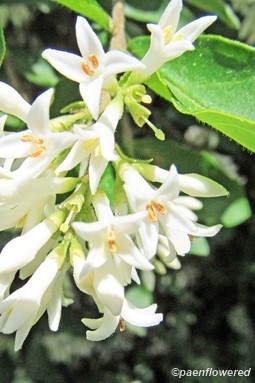Ligustrum obtusifolium
Ligustrum obtusifolium wild privet
This fast-growing, perennial multi-stemmed flowering shrub was introduced from Japan and China as an ornamental shrub. It has widely naturalized in the northeastern part of the United States, though the extent of its range is not well documented. It is a member of the olive family. In some areas it is considered an undesirable invasive, forming thickets if not controlled. It can grow up to 15 feet tall and can be trimmed as a hedge. The stem is smooth with smooth grey bark with short raised lenticels. Young twigs are light brown of reddish purple and hairy. Some plants may have thorn-like side branches.
The leaves of this species are arranged in an opposite manner on the stems. They are variable but generally ovate in shape. They range in size from ¾ - 2 inches long and about 1 inch wide. The middle vein is lightly hairy. The leaf stalks are short - only about ¼ inch long. An oval of pyramidal cluster of white flowers grows on the ends of leafy twigs. Individual flowers are ¼ to 1/3 inch long and the cluster is about 1-2 inches long. The fragrant flowers are trumped-shaped with a short tubular that is pale green or pale yellow in color and has four shallow teeth. The ends of the flower have four spreading lobes. Each flower has two stamens with yellow anthers and a single pistil. The stamens extend approximately to the base of the lobes.
The blooming period is in late spring and lasts about 1.5 weeks. The flowers provide both nectar and pollen for visiting insects. After the flowers whither, blue-black berries form. These may persist into the fall and winter.
The foliage is toxic to mammals and humans, but birds spread the seeds by eating the berries. The berries are toxic to humans. The common or European privet (L. vulgare) has also escaped cultivation and also grows in Western Pennsylvania. The twigs of that species are less hairy and the flower flusters larger than those of the border privet. There is enough variation within each species, though, to make exact identification difficult.
Habitat & Range
Naturalized in disturbed woods, thickets, old fields.
Biggest populations in the south.
Wetland code: Not classified
Phenology
Flowers in June.
Fruits September through winter.





Comments
Have you spotted this plant in your area? We'd love to hear about your experience! Share your comments or questions about the plant below. Comments are moderated before posting.